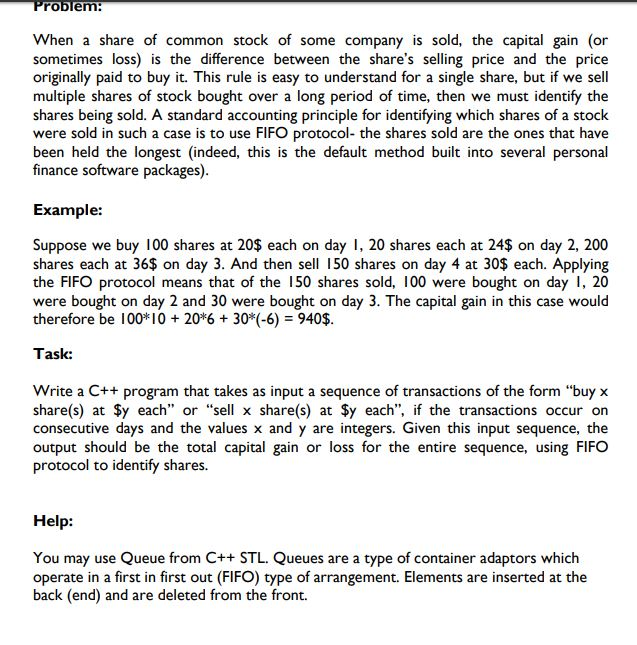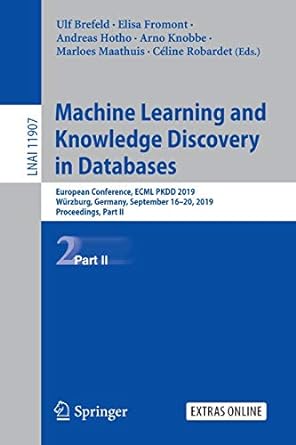Answered step by step
Verified Expert Solution
Question
1 Approved Answer
Need help with this C++ project. It does NOT take in any files, only input from the user. Please Use Queue. Thanks in advance! Problem:

Need help with this C++ project. It does NOT take in any files, only input from the user. Please Use Queue. Thanks in advance!
Problem: When a share of common stock of some company is sold, the capital gain (or sometimes loss) is the difference between the share's selling price and the price originally paid to buy it. This rule is easy to understand for a single share, but if we sell multiple shares of stock bought over a long period of time, then we must identify the shares being sold. A standard accounting principle for identifying which shares of a stock were sold in such a case is to use FIFO protocol- the shares sold are the ones that have been held the longest (indeed, this is the default method built into several personal finance software packages) Example: Suppose we buy 100 shares at 20$ each on day I, 20 shares each at 24$ on day 2, 200 shares each at 36$ on day 3. And then sell 150 shares on day 4 at 30$ each. Applying the FIFO protocol means that of the 150 shares sold, 100 were bought on day I, 20 were bought on day 2 and 30 were bought on day 3. The capital gain in this case would therefore be 100*10 + 20*6 + 30*(-6) = 940$. Task: Write a C++ program that takes as input a sequence of transactions of the form "buy >x share(s) at $y each" or "sell x share(s) at $y each", if the transactions occur on consecutive days and the values x and y are integers. Given this input sequence, the output should be the total capital gain or loss for the entire sequence, using FIFO protocol to identify shares Help: You may use Queue from C++ STL. Queues are a type of container adaptors which operate in a first in first out (FIFO) type of arrangement. Elements are inserted at the back (end) and are deleted from the front. Problem: When a share of common stock of some company is sold, the capital gain (or sometimes loss) is the difference between the share's selling price and the price originally paid to buy it. This rule is easy to understand for a single share, but if we sell multiple shares of stock bought over a long period of time, then we must identify the shares being sold. A standard accounting principle for identifying which shares of a stock were sold in such a case is to use FIFO protocol- the shares sold are the ones that have been held the longest (indeed, this is the default method built into several personal finance software packages) Example: Suppose we buy 100 shares at 20$ each on day I, 20 shares each at 24$ on day 2, 200 shares each at 36$ on day 3. And then sell 150 shares on day 4 at 30$ each. Applying the FIFO protocol means that of the 150 shares sold, 100 were bought on day I, 20 were bought on day 2 and 30 were bought on day 3. The capital gain in this case would therefore be 100*10 + 20*6 + 30*(-6) = 940$. Task: Write a C++ program that takes as input a sequence of transactions of the form "buy >x share(s) at $y each" or "sell x share(s) at $y each", if the transactions occur on consecutive days and the values x and y are integers. Given this input sequence, the output should be the total capital gain or loss for the entire sequence, using FIFO protocol to identify shares Help: You may use Queue from C++ STL. Queues are a type of container adaptors which operate in a first in first out (FIFO) type of arrangement. Elements are inserted at the back (end) and are deleted from the frontStep by Step Solution
There are 3 Steps involved in it
Step: 1

Get Instant Access to Expert-Tailored Solutions
See step-by-step solutions with expert insights and AI powered tools for academic success
Step: 2

Step: 3

Ace Your Homework with AI
Get the answers you need in no time with our AI-driven, step-by-step assistance
Get Started


